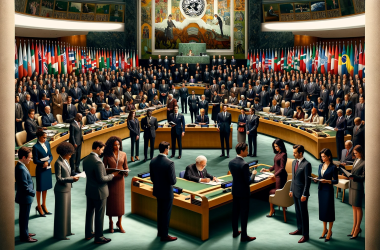Commentary
2023 October 31

Making an environmental treaty
During an informal chat with a former colleague, the question arose how environmental treaties come about. I shared a few exciting adventures I’ve had with this – and promised to make a short list of considerations.
Here it is:
Developing a global treaty is a complex process. There is not one, unique process -- it can take a variety of routes. The points below are not an attempt to describe the development in detail, but offer a first set of considerations. In fact, each point may warrant a separate paper to go into the nuances and details, including specific pitfalls and opportunities.
1. A treaty is an instrument of public international law. Treaty obligations are commitments upon countries. Hence, countries (nation states) have the lead and the decision-making authority in the development of a treaty. While support and input from many other actors are crucial (private sector, citizens and NGOs, relevant UN Agencies, research institutions), treaty making remains an intergovernmental process.
2. Treaties appear under a variety of names. Examples include: Agreement, Protocol, Accord, Amendment. However, it’s the content that determines the legal status of a treaty -- not the name. Regardless of the name, a treaty is an instrument of pubic international law that creates legally binding obligations for those countries that are a Party to it.
3. While it is not a legal prerequisite, environmental treaties are best initiated at the UNEA – the United Nations Environment Assembly. The UNEA is the governing body of the United Nations Environment Programme – not to be confused with the General Assembly of the United Nations.
4. In broad terms, four stages of development can be distinguished: First, a group of countries initiate the idea to develop a treaty and try to put it on the agenda of UNEA. Second, the UNEA plenary needs to accept the idea and decide on the establishment of an INC – an intergovernmental negotiating committee, with the mandate to develop a legally binding instrument. Third, after successful negotiations, the product of the INC will be a treaty text. Fourth, a treaty text needs to be adopted, after which the process of signatures and ratifications commences.
5. Following from the first stage mentioned in point 4 above: initiating the development of a new treaty (also for non-state actors) thus starts with building a small coalition of countries, supported by some key (non-governmental) organizations or institutes.
6. Some new treaties are stand alone. Others are linked institutionally and/or administratively to existing treaties or organizations. The tendency in the UN is to give preference to that latter approach – so as to remedy the current fragmentation and possible duplication of work and effort.
7. Obviously, the content and goals of the treaty need to be clear. What often gets the most attention are the negotiations on substantive positions, stakeholder participation and expert input – and, of course, any financial mechanism. However, what is less glamorous, and often left to a smaller group of legal negotiators, is the institutional and procedural structure of the treaty. Still, the success of a treaty depends heavily on that structure. The best content can be seriously undermined by a flawed treaty structure. An explanation of a 21st Century, future proof treaty structure (and what to avoid), warrants a separate note.
8. In each negotiation, the positions and interests of the participating countries and stakeholders will vary widely. How to successfully bridge those differences depends to a large extent on the skills of the Chair(s) of the negotiations. For this informal note it suffices to emphasize the importance of identifying, at the start, an institution or organization recognized by all participants to deliver objective and accurate science and data.
9. A few words on the content, and the development of position papers. The world is polarized. With almost any issue, a divide quickly emerges between developed-developing, rich-poor, economy-environment, etc. Useful position papers (that is, positions that gain support or find their way into negotiating texts) should focus on delivery mechanisms (how can results be achieved), on shared interests (what’s in it for you and me), and on visions of corporation and support (we are in this together). Listing demands, unattainable standards, or emphasizing on what countries must do, won’t work. The content should be such that countries want to join the treaty. Contrary to what some believe, this approach will not undermine the legal nature of the treaty, or make the treaty weaker – on the contrary.
10. Enjoy the journey! Successfully concluding a treaty takes time, determination and patience. At times it can be very frustrating, for both govenrment representatives and non-state participants. However, it would be difficult to overestimate the benefits of initiating or participating on such a journey. Numerous new contacts, a vastly expanded network, new insights and wisdom (even in your own field of expertise), a much deeper understanding of other countries, organizations or political processes --- the list of benefits is long and rewarding.
